Chrysler 300 First generation
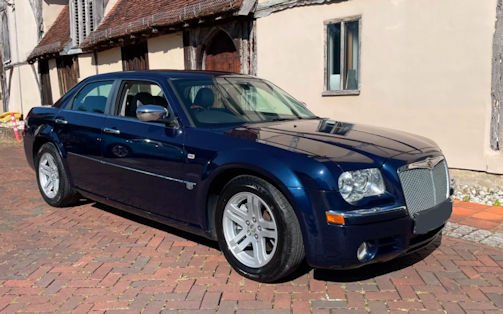 |
|
|
Production period: |
2004 to 2010 |
|
Class: |
Luxury Car |
|
Body versions: |
Sedan station wagon |
|
Engines: |
Gasoline : 2.7-6.1 litres (142-317 kW) |
|
Length: |
5015-5047 mm |
|
Width: |
1880 mm |
|
Height: |
1462-1507 mm |
|
Wheelbase: |
3048-3200 mm |
|
Curb weight: |
1805-2050 kg |
|
previous model |
Chrysler 300M |
|
successor |
Chrysler 300 (2011) |
The Chrysler 300 1st generation from 2004 is a passenger car built by Chrysler to 2010.
The 'C' in the model’s name means higher quality equipment that was standard for the European market. The letter C for the trim level was chosen because the Chrysler 300C "letter series" of 1957 served as a model for this successor. Also, optically it was based on the old 300C letter series and thus easily in the so-called retro look designed.
In early 2011, the second generation of the Chrysler 300 was introduced, which was offered in most European countries only under the name Lancia Thema (until October 2014). In the US, however, the model continues to be sold as a Chrysler 300.
The Chrysler 300 was originally a vehicle of the so-called "Letter Series" (letter series) of Chrysler, which was first introduced in 1955. Letter stands for the letter behind the series, which was previously counted with each model year in the alphabet. The name always starts with the model’s name 300, followed by a letter. It was always the most powerful model of the year, which - in contrast to other equipment variants or models - were only available as a two-door coupe or convertible. In 1957 there was already a first 300C. While normal 300s were offered further, the exclusive Letter Series was temporarily terminated with the 300L (1965). Only with the appearance of the Chrysler 300M in 1999, the last representative of the letter cars came on the market.
History
Was presented the new sedan of the Chrysler 300 for the first time in 2003 at the New York International Auto Show (NYIAS) as a near-series concept car, that the station wagon on the IAA in the same year and in the spring of 2004 as a production version whose formal Premiere the North American International Auto Show 2004 took place, for the 2005 model year.
The Chrysler 300 has in contrast to its predecessor rear-wheel drive and offered a level comparable to the predecessor Chrysler 300M comfort at a cheaper price. The 300 was offered in Europe only from the upscale equipment line 300C, the base model 300 was officially unavailable and reserved only for the American market.
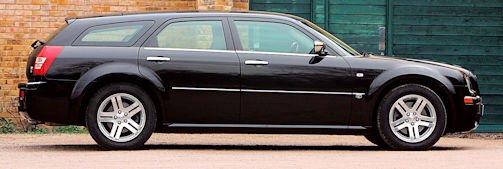
It also offered a station wagon of the 300, which received the name 300C Touring in Europe. In the US, a similar estate model was offered under the name Dodge Magnum.
The body of the Chrysler 300C Touring shares the strong sculptural appearance and the structure of the saloon from the distinctive front grille back to the A-pillars, but it has unique rear side panels, roof and rear liftgate.
The steel liftgate is shaped like an inverted “L,” and the hinges are set back over the load area so that the liftgate rises almost vertically and does not require the operator to step back from the vehicle. This unique liftgate architecture also allows for enhanced access to the rear cargo area. The liftgate, fitted with a two-speed wiper and wash system for additional customer convenience, can be unlocked using the button on the key fob and opened by the centrally mounted external handle.
Both the front and rear seats of the Chrysler 300C Touring are as spacious and comfortable as those of the saloon — with near identical head, leg and shoulder room — but the cargo area is 25 percent larger than in the saloon when the rear seats are up.
With the rear seats occupied, the Chrysler 300C Touring’s load area holds 630 litres (22.2 cu. ft.) of cargo, compared with the saloon’s 504 litres (17.8 cu. ft.). With the rear seats folded, 300C Touring’s cargo capacity is increased to 1,602 litres (56.6 cu. ft.). Within its competitive set, 300C Touring offers exceptional minimum and maximum cargo volume — more than Audi A6 Avant and Saab
9-5 Estate.
The load area features a removable, rollaway tonneau cover, large storage bins in each side panel, four cargo tie-down loops and a 12-volt power outlet. The load floor has a removable tri-fold panel that weighs just 7.25 kg (16 lbs.) and can be partially or fully folded, or completely removed. When used, small items can be stored below this floor panel. When removed, the maximum available load height is increased by 102mm (4.0 in.).
A cargo organiser and management system, which stores below the tri-fold panel, is standard on all UK vehicles. It includes a waterproof liner and folding divider with cargo retaining nets.
Additional cargo can be carried on the optional roof bars that come with two crossbars. Roof bar load capacity is 68 kg (150 lbs.).
In the summer of 2007 found facelift instead: The third brake light was now no longer integrated in the rear window, but in the trunk lid, which was a spoiler in the form of an implied spoiler. The headlights were larger and the taillights redesigned, so that the reversing lights were now at the bottom of the lamp unit. The interior has been designed significantly higher quality. The partial leather seats were now also available in anthracite. The ignition key was taken over by Mercedes-Benz.
All model versions share the Chrysler LX platform, which included numerous components from the Mercedes-Benz E-Class (210 Series) and also served as the platform for the Dodge Charger. Significantly taken over parts are in addition to the chassis, the front seat consoles, the wiring harness, the steering column, the five-speed automatic transmission and derived from the 4MATIC system four-wheel drive.

Drive and equipment
The Touring has the same impressive levels of standard kit as the saloon, with the addition of a rear cargo organiser and cargo cover. Standard features on the Chrysler 300C include Electronic Stability Programme (ESP) and an all-speed Traction Control System, front and rear side-curtain air bags, Xenon High-Intensity Discharge (HID) headlamps, rain-sensing windscreen wipers and a rear park assist system. Air conditioning and heated leather driver and front passenger seats also come as standard on all vehicles in the range.
Two options packs are available on 3.5-litre and 3.0-litre CRD vehicles in the UK. The “Driver’s Pack” comes with full-screen GPS sat-nav with 6-disc CD, and the “Luxury Pack” includes the Driver’s Pack plus sunroof and California walnut wood interior trim.
The 300C 5.7-litre V-8 HEMI® comes with the Luxury Pack as standard, so has an extra £2400 of standard equipment (sunroof, California walnut wood trim, full-screen GPS sat-nav with 6-disc CD) compared to the other cars in the range.
The range starts with the 3.0-litre CRD priced at £27,275. The 3.5-litre petrol is priced at £27,295 and £34,290 for the 5.7-litre HEMI.
In the UK, the Chrysler 300C is covered by Chrysler’s three-year, 60,000-mile warranty. The 300C is built in Graz, Austria.
The basic model 300C 2.7 comes as standard with 18-inch alloy wheels, a tire pressure monitoring system, cruise control, parking assistance, xenon headlights, four-disc brakes, traction control, electronic stability program (ESP), front, side and head airbags and a four- speed automatic transmission, it is powered by a 2.7-liter V6 gasoline engine with a maximum output of 142 kW (193 hp).
Suspension
The suspension architecture is similar in layout to the current Mercedes-Benz E-Class (W211). The short and long arm (SLA) front suspension provides excellent handling and ride characteristics. High upper control arms, which place the upper ball joints above the tyres, provide suspension articulation that helps keep the tyres perpendicular to the road during cornering for high adhesion. Lateral links and tension struts, rather than one-piece lower control arms, position the lower ends of the steering knuckles. These links attach to the steering knuckle via separate ball joints. Multiple bushings offer flexibility to tune for ride and comfort. This architecture creates a virtual pivot point for the tyre to reduce reaction to bumps that would otherwise be perceptible at the steering wheel.
The five-link independent rear suspension system allows independent tuning of handling and ride comfort so that each can be maximised for a no-compromise situation. The rear suspension has been developed to complement the performance of the front suspension for a very balanced vehicle. Multiple aluminium links maintain independent control of camber and toe during suspension movement for excellent handling. Multiple bushings offer flexibility to tune for ride and comfort. Stabiliser bar attachments to the knuckles provide maximum response to vehicle lean in the Chrysler 300C.
The rear suspension is isolated from the passenger compartment to provide a quiet and smooth ride. All rear suspension components, except the coil springs and shock absorbers, mount on a steel cradle that attaches to the body structure through four large rubber mounts. Premium urethane jounce bumpers provide smooth progressive engagement over sharp bumps to minimise harshness.
3.5-litre SOHC V-6 Engine
There is also a 3.5-liter V6 engine with a maximum power of 183 kW (249 hp) in the 300C 3.5.
The 3.5-litre V-6 engine used to power the Chrysler 300C is derived from versions of this engine used in prior Chrysler Group vehicles. An all-new active three-plenum intake manifold provides high power and torque over the entire operating band, with 185 kW (249 hp) at 6400 rpm and 340 Nm (250 lb.-ft.) of torque at 3800 rpm. This engine provides the perfect blend of performance and economy.
The new intake manifold with electronically controlled manifold tuning valve and short-runner valves provides more power to the 3.5-litre engine. Additionally, ETC is used on this engine.
5.7-litre HEMI V-8
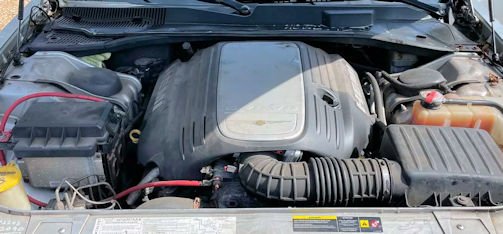
The 300C 5.7 has a 5.7-liter Hemi V8 engine. The control of this engine switched off at low power consumption four cylinders (cylinder deactivation) to reduce fuel consumption. If all eight cylinders are active, the engine delivered up to 250 kW (340 hp) and had a maximum torque of 525 Nm at 4000 rpm.
The introduction of the modern HEMI in Chrysler passenger cars marks several milestones. This engine offers more power and torque than any Chrysler passenger car engine since the legendary 426 HEMI of the ‘60s and ‘70s. Today’s new engine produces 254 kW (340 hp DIN) at 5000 rpm and 525 Nm (387 lb.-ft.) of torque at 4000 rpm.
The new HEMI has been engineered to deliver outstanding performance, while providing minimal noise, vibration and harshness, maximum smoothness and low emissions. Fuel economy has also been improved, but not at the expense of performance. Chrysler Group has developed, and will be the first to offer, a Multi-displacement System (MDS) on a modern, large-volume vehicle produced in North America.
“The Chrysler Group MDS seamlessly alternates between smooth, high fuel economy four-cylinder mode when less power is needed, and V-8 mode when more power from the 5.7-litre HEMI engine is in demand,” said Bob Lee, Vice President — Powertrain Product Team, Chrysler Group. “This optimises fuel economy when V-8 power is not needed, without sacrificing vehicle performance – Chrysler 300C owners will get the maximum benefit without any compromises.”
Owners of the Chrysler 300C will receive the powerful benefit of the HEMI engine with the fuel economy that they would only expect from a smaller, less powerful engine.
“The MDS was part of the engine’s original design,” added Lee. “This resulted in a cylinder-deactivation system that is elegantly simple and completely integrated into the engine design. The benefits are fewer parts, maximum reliability and lower cost.”
Some of the significant technologies enabling the Chrysler Group MDS are the speed of electronic controls, the sophistication of the algorithms controlling the systems and the use of Electronic Throttle Control (ETC). The HEMI will be able to transition from eight cylinders to four in 40 milliseconds (0.040 seconds).
The HEMI engine with MDS has completed more than 6.5 million customer-equivalent miles (10.5 million km) through Chrysler Group's development and durability testing.
The HEMI engine that powers the Chrysler 300C uses aluminium cylinder heads with hemispherical combustion chambers for outstanding airflow leading to high power and torque. Dual ignition (two spark plugs per cylinder) increases peak power and torque, reduces exhaust emissions, increases fuel economy and provides a smooth idle. The combustion system has been refined, and the engine uses direct-mount accessories for quiet operation.
ETC enables several of the technologies used to maximise vehicle smoothness, performance, safety and fuel economy.
The flagship model was the 300C SRT-8 powered by a 6.1-liter Hemi V8 engine with a maximum output of 317 kW (431 hp). It differs in addition to the stronger engine and the corresponding brakes both externally (20-inch wheels, aerodynamics package) and the interior (leather / Alcantara sports seats) of the other equipment versions. The exterior design also omits almost all the chrome elements that make up the other models.
3.0 CRD diesel engine
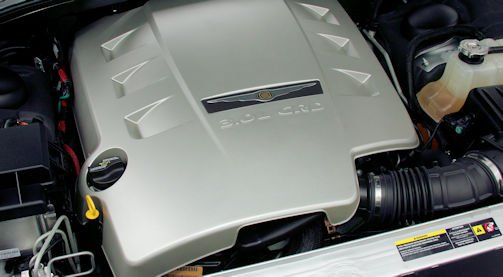
The 300C 3.0 CRD is powered by a six-cylinder diesel engine from Mercedes-Benz with standard particulate filter and a five-speed automatic transmission. This V6 engine with 3.0-liter displacement has a common rail - direct injection with piezoelectrically controlled injector, provides a maximum of 160 kW (218 hp) and developed thereby with a maximum torque of 510 Nm at 1600 rpm.
Based on the latest Mercedes-Benz technology, the CRD engine is fitted with Bosch high-pressure fuel injection (1600+ bar), a variable geometry turbocharger, four valves per cylinder with dual overhead camshafts, and Piezo injectors with a 0.1 millisecond response time. The new engine meets Euro 4 emissions standards and will include an integrated diesel particulate filter. Maximum power is 160 kW (218 hp DIN) and peak torque is 510 Nm (376 lb-ft) from just 1600 rpm.
For this powertrain, the choice of materials, design, fuel injection and engine management system reflect the state-of-the-art engineering adopted during its creation. Unlike many other diesel engines in this displacement and output class, the 3.0-litre V-6 CRD features an aluminium block with cast-in grey iron cylinder liners, which make a major contribution to weight reduction. As a result, the new V-6 weighs only 208 kg (459 lbs., according to DIN).
The diesel engine is an exceptionally smooth-running power unit due to enhancements such as low-friction valve gear, larger bearings for the crankshaft, connecting rods made from a new alloy and a counter-rotating balancer shaft between the cylinder banks. A quick-start glow system shortens preheating time to just a moment, so that the diesel is nearly as quick to start as a petrol engine.
The 3.0-litre V-6 CRD engine embodies third-generation common-rail technology. The result is a reduction in fuel consumption, exhaust emissions and combustion noise. With Piezo fuel injectors, adjust fuel supply to each cylinder. The number of fuel injections per power stroke has been increased from three to five, at a peak pressure of up to 1600 bar.
The engine was developed as a “one-box-concept” with the cylinder block, add-on components and ancillary units forming a uniquely compact power unit. The camshaft bearings are integrated into the cylinder heads and cylinder head covers, which saves space and cuts noise. The four camshafts are driven by a tried-and-tested double-bush timing chain system which also operates the balancer shaft and high-pressure fuel injection pump.
Four additional features are key to outstanding performance of the 3.0-litre V-6 CRD engine. A Variable Geometry Turbocharger (VGT) uses electronic adjustment to rapidly and precisely vary the angle of the turbine blades to maintain charge pressure over a broad range of operating conditions and enable the engine to generate high levels of torque even at low engine speeds. This turbocharger is combined with a downstream intercooler which reduces the temperature of the compressed, heated air by up to 95 degrees Celsius, allowing a larger volume of air to reach the combustion chambers. A newly developed valve control system for the 24 valves reduces both friction and moving masses. Electronically controlled intake port shut-offs adjust the turbulence of air entering the cylinders to optimise the combustion process and ensure three benefits – more power, lower fuel consumption and lower exhaust emissions.
For the 3.0-litre V-6 CRD unit, a W5A580 five-speed automatic transmission offers smooth shifts and optimum fuel economy. It features Electronic Range Select driver interactive shift control wherein the shifter provides fully automatic shifting in the “Drive” position, or the driver can manually select each gear sequentially by moving the shift lever left or right from the “Drive” position. This gives the driver the control to precisely match any driving requirement.
The 3.0-litre V-6 CRD engine is part of an impressive powertrain lineup. The 3.5-litre V-6 engine delivers high output, still with a perfect blend of performance and economy. For the ultimate in performance, Chrysler 300C customers can choose the 5.7-litre V-8 HEMI power unit.
In the 2005 model crash tests, the vehicle was rated according to US NCAP criteria with five stars in a head-on collision and by the IIHS in the attempt "Moderate overlap front" with "Good”.
The Chrysler 300C for markets outside of North America was manufactured in June 2005 at Magna Steyr in Graz. For the North American markets in Brampton, Ontario, Canada. Since the beginning of 2011 there is the eponymous successor Chrysler 300 (2011) , whose development was still running when Fiat was already taking over Chrysler, with new bodywork and other (never available in North America) diesel engine, which continues in the US as the Chrysler 300 in Europe, however, except for example in the United Kingdom, Ireland, Russia and Ukraine as part of the merger of Chrysler and Lancia until October 2014 as Lancia theme was offered. For the Lancia theme, there were matching emblems and conversion kits to make it look like a Chrysler. The technology was adopted to a large extent by the predecessor, so that, for example, in conjunction with the diesel engine continued to work a Mercedes 5-speed automatic transmission.
From 2004 to 2007, Barack Obama, later President of the US, drove a 300C.
Exterior colours include Brilliant Black Crystal Pearl coat; Bright Silver Metallic Clearcoat; Magnesium Pearl coat; Midnight Blue Pearl coat and Mineral Grey Metallic Clearcoat.
In the second season of the television series Desperate Housewives, 'Bree Van De Kamp' drives a Chrysler 300.
Chrysler 300C Safety Features:
- All-speed Traction Control System (TCS): All-speed TCS enhances mobility and prevents wheel slip when accelerating on road surfaces by operating both the brakes and the Electronic Throttle Control (ETC)
- Anti-lock Brake System (ABS): Equipped with electronic sensors that help prevent wheel lockup, the ABS system offers improved steering control under extreme braking and/or slippery conditions
- Auto-reverse Windows: An advanced sensing system automatically engages and reverses the window down to help prevent injuries to children
- Body Structure: Crush beads and stiffeners engineered into the vehicle body help absorb energy, while preserving the integrity of the vehicle compartment. These reinforcements provide additional protection in an offset-type impact
- Child Seat Anchor System (LATCH/ISOFIX): Lower anchors and tethers to ease installation of compatible aftermarket child seats
- Constant Force Retractors (CFR): The front seat belts include a mechanical device designed to distribute the force of a seat belt according to the load or force exerted on it. CFRs are engineered to force-limit the belt system, and gradually release seat belt webbing in a controlled manner during a severe crash
- Electronic Stability Programme (ESP): This feature aids the driver in maintaining vehicle directional stability, providing oversteer and understeer control to maintain vehicle behaviour on road surfaces
- Energy-absorbing Steering Column: Manual-adjust steering columns utilise two hydroformed coaxial tubes that can move relative to each other to allow the column to move forward and provide more energy absorption during a crash. The power-adjust steering column employs a calibrated bending element which deforms during column stroke for optimal energy management
- Enhanced Accident Response System (EARS): In the event of an accident, this system makes it easier for emergency personnel to see and reach the occupants by turning on the interior lighting and unlocking the doors after air bag deployment
- Multi-stage Air Bags: Multi-stage air bags deploy at three different rates depending on the severity of the crash. In lower-severity collisions, the air bag deploys with less force, and the force is increased during more severe collisions
- Pretensioners: During a collision, the impact sensors initiate the front seat belt pretensioners to immediately remove slack from the seat belts thereby reducing the forward movement of the occupant's head and torso
- Rear Park Assist: This system signals an audible warning and rear overhead display to aid in collision avoidance
- Side-curtain Air Bags: The side curtain extends protection to all outboard passengers
- Thatcham category 1 alarm system
- Tyre pressure monitoring system
- Xenon headlamps
Standard Specification
- Patented faux tortoise shell interior accents or optional genuine California Walnut wood accents
- Heated leather driver and front passenger seats
- Eight-way power adjustable front seats
- Driver and front passenger adjustable lumbar support
- Leather-wrapped steering wheel with flush-mounted audio, navigation and trip computer controls
- Dual driver memory system controls for driver’s seat, mirrors and radio presets
- Dual-zone automatic temperature control with infrared sensing
- Air filtration system
- Electronic Vehicle Information Centre (EVIC)
- Cruise control
- Express-up/down power front windows with anti-pinch protection
- Analogue clock
- 60/40 split folding rear seat
- Electrochromic interior and driver’s rearview mirror
- 18-inch five-spoke, split-spoke wheels
- Metallic paint
- Suspension levelling
- FM radio with single CD
- 6-speaker Boston Acoustic Audio System (280 watts)
- Rear cargo organiser and cargo cover
- Diesel engine features diesel particulate filter as standard
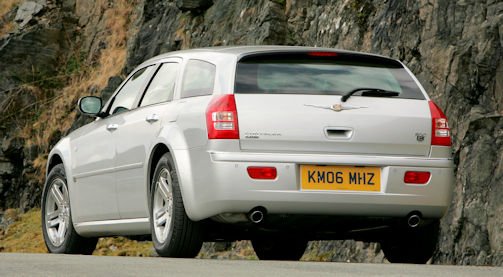
Technical
-
Technical data
In Europe, the Chrysler 300C was delivered in five variants:
model
Engine type
engine type
Displacement
cm³Max. Power
kW (PS) at rpmMax. Torque
Nm at rpmAcceleration,
0-100 km / htop speed
fuel consumption
transmission
years
2.7 V6
gasoline engine
V6
2736
142 (193) / 6400
257/4000
11.1 s
209 km / h
10.7 l / 100 km
4- speed automatic transmission
2004-2007
3.5 V6
3518
183 (249) / 6400
340/3800
9.2 s
219 km / h
11.1 l / 100 km
4-speed automatic transmission / 5-speed automatic transmission
5.7 Hemi-V8
V8
5654
250 (340) / 5000
525/4000
6.4 s
250 km / h
12.3 l / 100 km
5-speed automatic transmission
2004-2010
6.1 Hemi-V8
SRT86063
317 (431) / 6000
569/4600
5.4 s
265 km / h
14.2 l / 100 km
5-speed automatic transmission
3.0 CRD
diesel engine
V6
2987
160 (218) / 4000
510/1600
7.6 s
230 km / h
8.1 l / 100 km
